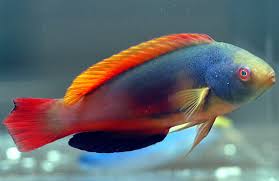Care Recommendations for Scott’s Fairy Wrasse Care Sheet

The Scott’s Fairy Wrasse, also known as Scott’s Velvet Wrasse, Scott’s Greenback Fairy Wrasse, the Black-fin or Blackedge Fairy Wrasse, originates from Cook Islands, Fiji, and Australia with a varied color representation for each location. Scott’s Fairy Wrasse from Cook Islands has a bluer coloration with yellow and more definitive breaks between color. Wrasse originating from Fiji, known as Scott’s Greenback Fairy Wrasse, are mostly green with a striking black section on the dorsal fin. The Australian variety contains more red on the fins with the less dramatic color break on the body.
Scott’s Fairy Wrasse Care Sheet:
- Care Level: Easy
- Temperament: Semi-aggressive
- Diet: Carnivore
- Reef Safe: Yes
- Max Size: 5-6 inches
- Minimum Tank Size: 125 gallons
Tank Requirements for the Scott’s Fairy Wrasse
In a home aquarium, it’s important to provide Scott’s Fairy Wrasse with excellent, consistent water quality, a bit of a current, and plenty of aeration. Provide enough live rock for an abundance of hiding places. As with all wrasse fish, keep a tight-fitting lid on your aquarium to avoid escaping.
Temperament of Scott’s Fairy Wrasse
The Scott’s Fairy Wrasse is a peaceful fish that will add both color and activity to a fish-only or reef aquarium of 125 gallons or larger. Typically, they won’t bother any coral or invertebrates. However, it is important to keep one male per tank with a group of females. Introduce females first, then the males. Larger males tend to be more aggressive toward other fairy wrasse males and other smaller wrasse species introduced after them. It’s recommended to avoid housing Scott’s Fairy Wrasse with intimidating fish such as larger species of Angels and Tangs. Keep all this in mind when planning the species in the aquarium
Diet of Scott’s Fairy Wrasse
The Scott’s Fairy Wrasse are carnivores, requiring food such as zooplankton, brine and mysis shrimp. They can also be fed quality pellet and flake food. With a high metabolism, several small feedings a day should be adequate to keep your wrasse happy.
Scott’s Fairy Wrasse species should be kept in a good environment and a temperature between 72 and 78°F. Maintain a pH value of 8.1-8.4, a salinity of between 1.020-1.025, nitrates and ammonia levels at 0 ppm, and dKH between 8-12.
Learn more about caring for Wrasses
Author: Christeena
















